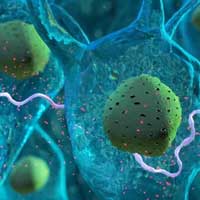Finally, Critical Obstacles in Lyme Disease Treatment and Diagnosis Mastered

Throughout America and Canada, a staggering number of patients suffer from memory loss, joint pain, flu-like symptoms, chronic fatigue and muscle aches, among other complex neurological symptoms. Strangely, these patients are being told their condition is all in their head. Even when diagnosed correctly, these patients struggle for years to find the proper treatment. In this article, we explain how these symptoms and diagnoses are linked to infections and how to receive the most effective treatment.
In many cases, patients are given a diagnosis of rheumatoid arthritis, lupus, scleroderma, fibromyalgia or some other autoimmune disease, and then are referred to a rheumatologist, pain management specialist, or a psychiatrist. Doctors are told by the CDC (Center for Disease Control) that the chronic infection of Lyme disease and tick-borne illnesses are nonexistent, so they must find another diagnosis. All of this is enriching major pharmaceutical companies, making patients and their families endure unnecessary suffering.
The poor diagnosis of fibromyalgia and other autoimmune diseases is another way the conventional system places patients on a lifetime of medication management, with poor quality of life, and terrible side effects, including accelerating aging and degenerative diseases. But the truth is that these types of diagnoses tell you nothing about what is actually causing the disease. We will hopefully provide helpful insights in this article so that patients can better understand Lyme disease and receive the specialized treatment they so desperately need. We have over a decade of experience in transforming the lives of patients' to prove it.
How This Disease Is Growing Out Of Control
Americans alone are on over 650 billion dollars of pain medication annually. With the advent of the Affordable Care Act, those numbers are only set to rise. In modern medicine, the answer to treatment is managing symptoms, keeping people in bondage and reducing their quality of life while accelerating their aging process within their entire body. Are these conditions really in your head or do you in fact have another condition that is linked to all of these symptoms? In our clinical experience and over a decade of working with patients, we have found a massive misdiagnosis of chronic Lyme disease, tick borne infections, as well as virus, fungal and parasitic infections.
The problem is that if you have infections the only way to heal the body is to properly kill those infections and allow the immune system to regain its place. Otherwise, no amount of pain killers, sleep aids, anti-depressants or anti-inflammatory drugs are going to stop these infections from deteriorating the patient's brain, hormonal function and entire nervous system. No other form of treatment or Band-Aid approach will work.
To make this easier to understand, let's define Chronic Lyme Disease Complex (CLDC), based on our ten plus years of clinical experience and our Lyme literate medical doctors' experience with treating chronic infections, fibromyalgia and autoimmune diseases. Envita defines CLDC as involving one or more factors: Lyme disease; its co-infections; the reactivation of dormant infections, such as viruses; and an immune compromised state that can be further complicated by heavy metal and chemical toxicities. How this differs from the CDC's definition is, they are treating Lyme disease in a vacuum as one infection and not clinically correlating it to the complete complex diagnosis that is typically seen in patients.
Reported Nationwide Numbers Tell It All
The nationwide numbers of 300,000 new cases a year explain why so many are suffering, unable to get the correct diagnosis, adding to the controversy surrounding diseases such as chronic Lyme disease complex, which is characterized by a massive misdiagnosis of tick-borne diseases.
Welcome to the controversial world of idiopathic, autoimmune and chronic illness, where patients who continue to suffer with poor quality of life are caught in the middle.
Lyme disease is perhaps the best example of how the medical industry misdiagnoses or completely misses many terrible, often life-threatening diseases that need specialized treatment. For example, the infectious disease specialists are told straight from Mendel's Infections disease textbook that patients cannot have chronic Lyme disease if the lab tests (western blot test and ELISA test) come back negative. Mandel's textbook itself encourages doctors to look for another disease or another diagnosis.
But these tests are immune system sensitive tests that miss well over 50 percent of cases. Why? Simply put, a patient's immune system is far too compromised or weak to respond in many extended cases, so the test returns with a false negative. Therefore, the immune system must be tested first to include more detailed infectious profiles with a correct patient history and symptom list. This is the most accurate way to achieve the correct diagnosis and help the patient towards improving their quality of life. Too many people suffer needlessly this way, but luckily there is much better way to go.
Treatment That Really Matters
So what does this grave misdiagnosis translate to? A massive diagnostic influx of fibromyalgia, chronic fatigue syndrome, autoimmune diseases and neurological conditions that are all idiopathic (meaning these conditions have no real known cause or causes). Remember, fibromyalgia was believed to be in everyone's head until Lyrica was mass-marketed and prescribed, allowing pharmaceutical companies to do what they do best: making billions by managing symptoms, never really healing patients and keeping them on expensive medication for a lifetime.
With the advent of the Affordable Care Act, more drug prescriptions will be filled as the government will pay the bill and encourage a lifetime of symptomatic care. However, this does little for treating the real underlying causes of disease, merely managing symptoms. And this is the case for far too many diseases, not just Lyme.
What we are saying is that the previously mentioned conditions often fall under infectious diseases. It's proven when profiles from bacteria, viruses, fungi and parasites come back positive on these patients. Getting the right diagnosis is one thing, but it's also important to get the right treatment.
What True Lyme Disease Treatment Looks Like
Effective Lyme disease treatment isn't a very complex idea – its principle is looking at the patient as a whole being with interconnected systems and then treating each individual cause. This regimen includes things like immunotherapy, nutritional therapy (looking at the patient's diet and exercise routines), toxicity levels and chemical poisoning and detecting infections such as parasites, fungi, bacteria and viruses.
Because most conventional medical institutions can rarely even get a diagnosis for Lyme disease right, it's not surprising the treatments offered are symptomatic or routine antibiotic doses that don't get to the core of the disease. If your doctor misses many of Lyme disease's co-infections, chemical toxins, or fails to rebuild the immune system or weighs many of the other factors involved with Lyme disease, it's no wonder the condition can become chronic. This is why many patients find themselves going from doctor to doctor, trying many different but standard treatments, without ever restoring their quality of life or reaching remission.
Those following the Center for Disease Control or infection disease specialists often don't improve. Instead, they live with a lifetime of whatever disease they've been pigeonholed into, because their doctor needed to find a diagnosis for the patient that fits, usually one that is only managed with a lifetime of prescriptions.
In contrast, those that have found the correct Lyme literate doctor and get treatment, see improvement. In our experience, an overwhelming number of patients have a massive increase in quality of life and a great turnaround in their health when they follow this advice. The reason for this is simple: when you test and treat all infections and clinical complications, patients finally get a breakthrough and get their life back. With only a small group of doctors, most offices require years of treatments. Using mainly IV antibiotics, our team is accomplishing much more in just several weeks of care by customizing the treatment plan for each patient. Now you can see why proper treatment is more vital than ever, especially as more and more cases of Lyme are reported each year.
Lyme disease may just be an example, but it's an important one. Patients deserve to get well, not suffer just because the infectious disease community hasn't figured out latent chronic infections like Lyme disease. We're passionate about the subject, because this is what we do every day: help our patients heal. If you have any questions about chronic Lyme disease complex or other idiopathic conditions and our unique and helpful approach, feel free to contact us.























